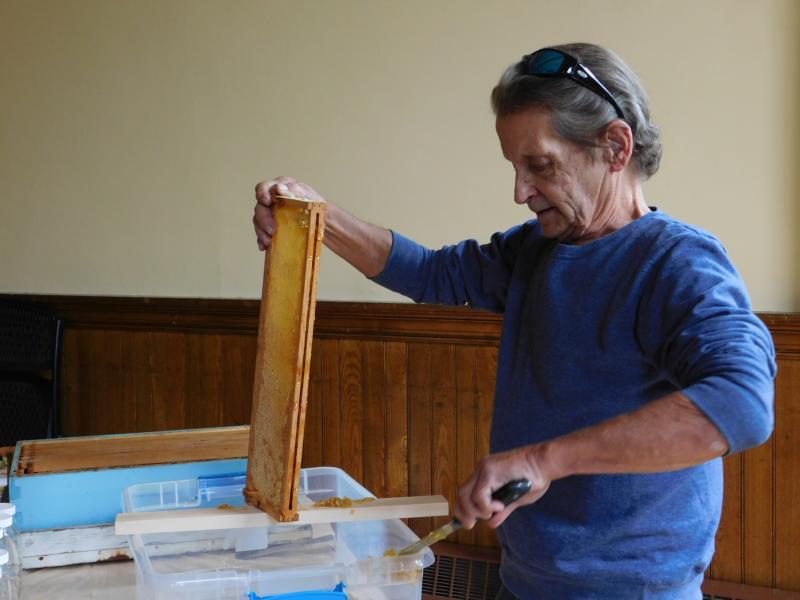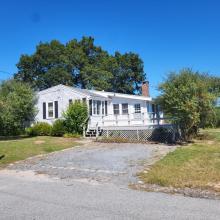Buzz buzz: Wareham beekeeper says bees are looking for a boost
They buzz through cranberry bogs, into people's gardens, and into apple trees. Occasionally in the summer, it seems like you can't go a day without seeing a hardworking bee or 20, buzzing loudly.
In New England, alongside the rest of the United States, though, bees are on the decline. The busy little pollinators are looking for a little extra help.
“Seventy-five percent of the world’s flowering plants need help from a pollinator,” explained Wareham-based beekeeper and cranberry grower Linda Rinta. “That number is even higher in New England, where farmers in the present day are being pushed to produce more food on less land.”
Rinta and her husband Paul visited the Marion Music Hall on Sept. 29 as guests of the Marion Garden Group and Sippican Lands Trust to discuss the plight of bees, and how interested parties can help.
Local farmers have two pollinator options if they want their fruit and vegetables to grow properly: honeybees or bumblebees.
Honeybees, originally from the tropics, arrived in the United States back in the 1600s, when colonists needed the sugar from their honey to brew liquor. Honeybees colonize a hive, work as a group and produce honey. Their honey stores also make them much more likely to sting.
Native bumblebee species, on the other hand, don't produce honey. “Therefore they won’t sting unless they feel really threatened,” Rinta said, “because they don't have anything to protect. So they’ve never developed a defensive instinct.”
The bumblebees also don't colonize, to an extent. “They're not going to stay in a box you give them like honeybees would,” she explained. “If they don’t have a reason to stay, they won’t.” Bumblebees don’t think as a hive mind and don’t set up a central hive the way honeybees do.
Both honeybees and bumblebees are facing severe threats though. They’re quickly losing grazing ground.
“Back in the day, we had a lot more open fields and meadows,” Rinta noted. Since the 1970s, trees have grown back where the meadows were, or they’ve been replaced by houses as small-farm agriculture becomes less financially-viable.
Mature forests are not friends to the honeybee or the bumblebee, Rinta explained.
“You'll never hear a bee buzz in those woods. There are no flowering plants for them to feed off of.”
The bees have also been weakened by tracheal and varroa mites, both arrived with imported crops. The mites latch onto any bee they find and weaken them, making the bees far less likely to survive the winter.
The prolific use of pesticides, particularly on ornamental flowering plants, is also killing off bee populations. Imidaclopoid and clothianidin, common ingredients in popular garden pesticides, are lethal to bees. They can remain in plants for up to four years. “The pesticides promise four years without bees, and now you know how they do it,” Rinta said.
Rinta noted that a lot of people are interested in becoming beekeepers, particularly as they retire and want a hobby. “They're afraid of being stung though, and it will happen,” she said. “They're protective of their honey.”
There is one solution for a garden owner looking to help a friendly bee. Mason bees, a type of native bumblebee, are calm, unflappable workers. Male mason bees cannot sting. Female bees rarely sting, as they have no defensive instinct, so they’re ideal for people with children or who are scared of bee stings.
“They live in little tubes,” Rinta explained, showing off a mason bee house that her husband Paul had constructed. “They gather pollen for 30 days, that's all you'll see of them. Then, they live in their little tubes and don't bother anybody. They're my favorite, favorite bee.”
Bee-friendly gardens (for mason bees or any bees) include aster, wild bergamot, black-eyed susans sunflowers, dogwood trees and hydrangeas.
To learn more about bee conservation, pollinator plants and other resources, visit http://xerces.org/pollinators-northeast-region/.
To build your own mason bee house, visit http://www.nwf.org/Garden-For-Wildlife/Young/Build-a-Bee-House.aspx













